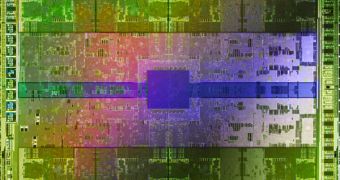The Fermi architecture has been delayed for months but it seems that NVIDIA will finally be able to push mass availability of Fermi products in the second quarter of the company's fiscal year 2011. Currently, NVIDIA is planning on ramping up production of Fermi chips in the first quarter of its FY 2011, namely at some point between January 31 and April 30. This, however, means that mass availability of Fermi products won't be achieved except after the actual product launch of the GeForce GTX 400-series graphics cards.
NVIDIA's Fermi will span a number of price ranges and, besides powering the GeForce GTX 470 and GTX 480 graphics cards, will be used in products form the GeForce Quadro and Tesla series. The GTX 470 and GTX 480 are currently expected to come out in March or April, which implies that mass availability will only come after that.
“Q2 [of FY 2011] is going to be the quarter when Fermi is hitting the pull stride. It will not just be one Fermi product, there will be a couple of Fermi products to span many different price ranges, but also the Fermi products will span GeForce Quadro and Tesla. So, we are going to be ramping now on Fermi architecture products through Q2 and we are building a lot of it. I am really excited about the upcoming launch of Fermi and I think it will more than offset the seasonality that we usually see in Q2,” said Jen-Hsun Huang, chief executive officer of Nvidia, during the most recent conference call with financial analysts, the report claims.
It appears that AMD will still have a little more time to bask in its DirectX 11 glory and NVIDIA will have to somehow keep as much of its market share as it can with just its current products. Still, the latter doesn't seem all that concerned and believes that owners of mainstream or entry-level cards don't really need new functionality. The company's CEO also mentions that the marketing performance of Fermi will depend on the 40nm yields.
“All of that just depends on 40 nm supply and we are trying to finesse it the best we possibly can. For the entry-level products, the truth is that the new architectures […] are probably not extremely well appreciated anyhow. People, who buy the new architectures, tend to be early adopters and they tend to be the game enthusiasts, workstation designers or creative artists or – there are very specific reasons why it really enhances their experience. Our current generation GPUs are fabulous and all the things that mainstream consumers would use their computer for. […] I think the mainstream GPUs are really fabulous and has been enhanced recently with some really great features and so my sense is that they are going to continue to do quite nicely in the marketplace. Then we will just transition as fast as we can,” stated Mr. Huang.
NVIDIA's lack of concerns is likely at least in part owed to its revenue and profit growth during the fourth quarter of FY 2010. Unfortunately, the GPU maker's chief executive didn't give any details on the timeframe for the company's transition to the Fermi architecture.

 14 DAY TRIAL //
14 DAY TRIAL //